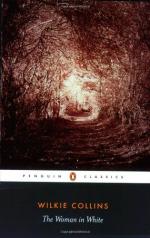Mr. Kyrle rose when I resumed my seat, and declared, as the legal adviser of the family, that my case was proved by the plainest evidence he had ever heard in his life. As he spoke those words, I put my arm round Laura, and raised her so that she was plainly visible to every one in the room. “Are you all of the same opinion?” I asked, advancing towards them a few steps, and pointing to my wife.
The effect of the question was electrical. Far down at the lower end of the room one of the oldest tenants on the estate started to his feet, and led the rest with him in an instant. I see the man now, with his honest brown face and his iron-grey hair, mounted on the window-seat, waving his heavy riding-whip over his head, and leading the cheers. “There she is, alive and hearty—God bless her! Gi’ it tongue, lads! Gi’ it tongue!” The shout that answered him, reiterated again and again, was the sweetest music I ever heard. The labourers in the village and the boys from the school, assembled on the lawn, caught up the cheering and echoed it back on us. The farmers’ wives clustered round Laura, and struggled which should be first to shake hands with her, and to implore her, with the tears pouring over their own cheeks, to bear up bravely and not to cry. She was so completely overwhelmed, that I was obliged to take her from them, and carry her to the door. There I gave her into Marian’s care—Marian, who had never failed us yet, whose courageous self-control did not fail us now. Left by myself at the door, I invited all the persons present (after thanking them in Laura’s name and mine) to follow me to the churchyard, and see the false inscription struck off the tombstone with their own eyes.
They all left the house, and all joined the throng of villagers collected round the grave, where the statuary’s man was waiting for us. In a breathless silence, the first sharp stroke of the steel sounded on the marble. Not a voice was heard—not a soul moved, till those three words, “Laura, Lady Glyde,” had vanished from sight. Then there was a great heave of relief among the crowd, as if they felt that the last fetters of the conspiracy had been struck off Laura herself, and the assembly slowly withdrew. It was late in the day before the whole inscription was erased. One line only was afterwards engraved in its place: “Anne Catherick, July 25th, 1850.”




